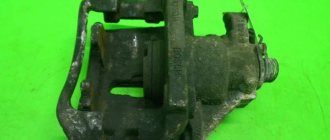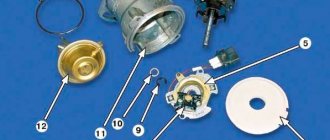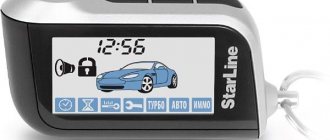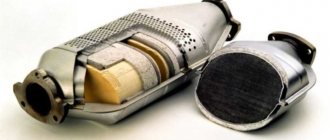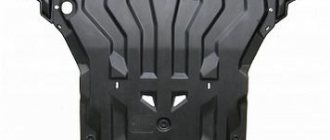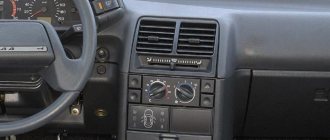Polarity - the location of the connecting terminals on the battery cover, which are current-carrying elements. Since there are only two poles - positive and negative, there are few options for their location - forward and reverse. We will consider in relation to what it is customary to determine the location of the terminals, what will happen if the poles are accidentally mixed up when a polarity reversal is deliberately done.
What does forward and reverse battery polarity mean?
The terminals on the battery are always located in a certain sequence, according to the standard of the countries of origin. There are only two terminals, plus and minus. They may have different positions, but it turned out to be most convenient for maintenance to place the terminals on the cover. Moreover, they can be raised or recessed, distinguishing the European and Asian types.
The terminals are conveniently located on the cover on both sides. Direct and reverse polarity distinguish batteries only by changing the location of the poles. If straight, they consider the position when you read the inscriptions on the front side, and your right hand touches the right plus button. Reverse position - the same hand touches the negative button.
This is important to consider when buying a battery to replace an old one. Connecting the terminals the other way around will be inconvenient; you will have to extend one wire and shorten the other.
Differences between positive and negative terminals
First, it is advisable to understand the structure of the battery, the most common type of which is lead-acid. It is a plastic box divided into 6 sections, each of which is a separate battery. Each section contains a package of plates with alternating polarity. Lead dioxide is applied to the plates with a positive charge. Sponge lead is used for those having a negative charge.
The terminals can be distinguished by their appearance; European ones are cylindrical in shape, that is, they have a round cross-section. Asian ones are divided into two varieties; they can be round or flat. If flat ones are used instead of round ones, they are often threaded. The difference in size is also observed: in European ones the minus diameter is 17.9 mm, and in Asian ones it is 11.1. The positive contact in European cars has a diameter of 19.5 mm, in Asian cars - 12.7.
If a battery with a different polarity is installed, the contacts are not connected due to the difference in diameter. Connection is only possible through a special adapter. Another difference between the two types is that in European-type batteries, the terminals are hidden in niches, so they do not stand out on the body. In Asian ones, they rise above the lid and, when installed on another car, can even rest against the hood. The main differences between terminals with different charges are shown in the table:
| Main Differences Between Positive and Negative Terminals | ||
| Plus | Minus | |
| Location | Direct polarity or “Asia” is the terminal on the left, reverse polarity or “Europe” is on the right. | Forward polarity is the terminal on the right, reverse polarity is on the left. |
| Size | "Asia" - 17.5 mm, "Europe" - 19.5 mm. | "Asia" - 11.1 mm, "Europe" - 17.9 mm. |
| Color of cap or identification ring | Red | Blue, grey, black or silver. |
| Form | They have the same shape - cylindrical; in Asian batteries they can be flat. | |
| Height | They do not differ in height; in “Europe” type batteries they are located in niches on the lid, in “Asia” type batteries they rise above the lid. | |
How to determine whether the battery polarity is direct or reverse
Each battery has a front side with marketing and informational stickers. If you place the battery facing you, the terminals are located on the right and left.
“Straight” polarity is sometimes marked with the number 1. This is a Russian battery layout. If the battery is facing forward, the plus button is under the left hand, red or with a grooved plus. Right – negative
“Reverse” polarity in the classifications of Fr. To decide, you need to place the battery facing you. The left hand will rest on the negative terminal, and the right hand on the positive terminal.
Direct and reverse polarity indicate the difference in the internal circuit of the cans' contacts on one side or the other. In practice, this means that when replacing a battery, the owner can mix up the poles when connecting to the car tires.
Useful video
Here is an example of the consequences that will occur in a car if the battery polarity is reversed:
When charging the battery
When charging a battery, it is much more common to mix up the terminals than when installing it on a car. The problem is that the terminals of the crocodile charging blocks are sometimes the same size and appearance.
This is interesting: How to charge batteries with a frog
If during charging it was discovered that the polarity was reversed, then you simply need to change the polarity and continue charging the battery, after first checking it for functionality.
If the error was discovered after the battery was charged, then this situation will be a little more difficult to resolve. This is due to the fact that “reversal” has already begun inside the battery. In other words, now the minus “-” has become a plus “+” and vice versa.
To fix this situation, you first need to completely discharge your battery. This is done by turning on the brake light and dimensions. You can also connect a car light bulb. Once the battery is completely discharged, you need to connect it to the charger again, but this time it is very important not to mix up the terminals and connect it correctly. Once charging is complete, the battery can be used again.
If you reverse the polarity of the battery during home charging, then in almost 95% of cases the charger will fail.
Almost all chargers have a special fuse, which burns out in such cases, but thereby preserves the functionality of the battery. In such a situation, you will need to purchase a new fuse and replace it, and next time, carefully monitor the polarity of the terminals.
What does reverse battery polarity mean?
Reverse polarity means there is variability in the fit - the relative arrangement of battery poles, even from the same manufacturer, can be forward and reverse. This allows for more efficient use of the engine compartment space, creating a convenient layout. It is all the more important to choose exactly the same battery. If the polarity is reversed, whether in a truck or a car, the cathode will always be under the right hand, provided the battery is positioned correctly.
How are batteries different?
The differences are minimal, except for the pole. I would like to note that externally the batteries are almost identical - that is, the body, the number of cans, the current strength, and even the label. And it is very easy to confuse the battery, that is, you can buy it with the wrong location of the current leads (terminals). Even an experienced driver can get into trouble if he makes a spontaneous choice. Therefore, if you yourself do not understand this, ask the seller to choose one for your car; as a rule, they have catalogs that describe suitable models. It will be best this way!
Therefore, if you are thinking about replacing the battery, you need to know exactly and determine the location of the terminals, this is extremely important!
Changing battery polarity
Reversing battery polarity can happen accidentally or intentionally. If you mix up the terminals when lighting a cigarette, there are material costs for both the donor and the acceptor.
If you accidentally changed the polarity in your car, then at best the main fuse will burn out, at worst - the diode bridge. The faster you notice the jamb, the less the loss.
Changing the polarity, like reversing the polarity, is used to restore the functionality of a sulfated battery. The battery eats lead sulfate with appetite, cleaning the plates. But polarity reversal means the battery operates contrary to the rules. The forced measure must be temporary. It is much better to use a double polarity change when desulfating.
Terminal designation
What might the markings on the terminals mean? As shown in the photo, the terminals can have several types of markings, by which the polarity of the battery can be determined. There are only 3 options used in the world:
- “+” and “-”;
- "POS" and "NEG";
- "P" and "N".
These designations were introduced for a reason, so you need to understand the marking designations of a car battery. If you mix up the connection, there will be many problems. Not all blocks and modules in the car are equipped with additional protective components that will prevent polarity reversal - therefore they will fail, at the same time fuses will blow and many current sources in the circuits will overheat. Due to the likelihood of a short circuit, the battery itself can be seriously damaged.
What it is?
What is battery polarity? This is a type of placement of current leads on a battery. The most popular varieties are “reverse” and “direct” polarity. But that’s not all - there is a wide range of other types of conclusions that, due to certain circumstances, could not become popular in the Russian Federation and other countries.
In other words, the polarity of the battery is determined by the location of the terminals - sometimes the positive one can be found on the right, sometimes on the left. This is the difference.
Basic battery parameters
When choosing a battery for your car, you need to look not only at the polarity of the battery. It is also necessary to check all other characteristics and take an old battery for comparison. It will contain the following information:
- Plus is always signed with a “+” sign or the letter “R”. Russian labels will indicate “gender.” or "p." and "arr."
- Battery capacity. This parameter is indicated in the form of A/h and tells us how long the battery will work before being completely discharged. You should buy a device with the same or 5% larger capacity so that it is enough. The best ratings will not always include batteries with the highest capacity. For example, better-made batteries with lower performance can last longer.
- Starting current. It indicates the ability of the source to start the engine in winter during severe frosts. Different manufacturers perform tests differently, but the results are approximately the same. For operation in a cold climate zone, it is better to buy a device with a large starting current, as it will sag significantly.
Is it possible to install an incompatible battery if you don't have the right one on hand?
The difference between correct and incorrect polarity is not only the location of the current carrying elements. If the designation is chosen incorrectly, to install such a power source you will have to lengthen the wiring, which is fraught with a number of negative consequences.
- Incorrect calculation of wire cross-section is possible. As a result, they will burn out.
- Quickie. The presence of an additional connection point for wires can negatively affect current transmission.
- Short circuit.
- Short circuit in the power supply. It is not possible to replace it under warranty conditions.
What are the consequences for a car owner when the polarity is reversed?
It is important to remember: the design of the car assumes the use of only batteries of a certain size and terminal location. It is possible to install a battery of similar capacity, but not the correct polarity, into the seat. But it will no longer be possible to connect it in standard mode. Because the wires simply won't reach.
It is no coincidence that such a difference between batteries is present: incorrect polarity will cause damage to the car’s electronics. The engine control unit may fail and a short circuit may occur. It is important to remember: not all electrical appliances fail when changing poles. But many will be damaged. Such situations should be avoided.
Moreover, in some cases, the holes in the terminals are even different. Usually the diameter of the positive one is slightly larger than the negative one. Therefore, it will be difficult to confuse them even by accident. Moreover, changing the poles can cause the starter to rotate in the other direction. Some engines may require major overhaul after this.
We recommend: Main types of passenger car suspensions
What are the consequences if the terminals are mixed up?
The consequences may be different, depending on the situation in which the terminals were mixed up.
When installed on a vehicle
In the event that the plus “+” with the minus “-” on the battery were mixed up at the time when the battery was installed on a car with a running engine, then the owner of the vehicle will receive a fairly large number of troubles, ranging from the fact that it may fail generator diode bridge, as well as other electronic devices in the car.
Most often, this situation happens with old vehicles, where there was no protection against incorrect battery connection.
Important! A battery that has been connected incorrectly and left in the vehicle for a long time can cause a short circuit and fire.
In the event that the terminals are mixed up and the car does not start at this moment, then the owner will face much less problems.
In such a situation, only devices that were turned on earlier, for example, a radio, clock, etc., can fail. Sometimes, the situation is saved by blown fuses that are installed in the power circuit, naturally, if they meet the requirements of the maximum current in the circuit.


